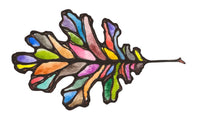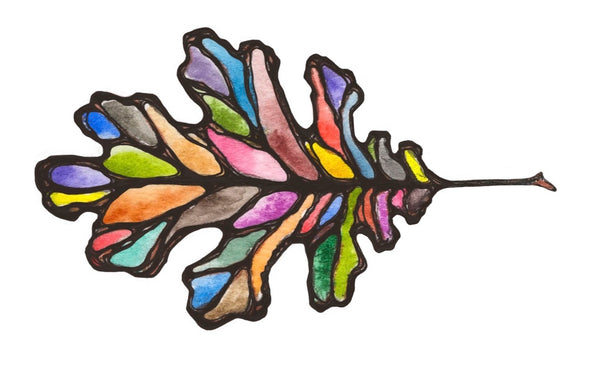
How To Create A Color Pyramid
One of my favorite watercolor tools is the color pyramid. Painting one is an enjoyable way to quickly put a few colors through the paces - and it leaves you with both a pleasing painting and a useful reference tool.
A Little History...

Most people are familiar with color wheels, to which a color pyramid is very similar, but organized and presented just a little differently. Tobias Mayer, a German mathematician and astronomer active in the eighteenth century, devised a color triangle in the pursuit of identifying the exact number of colors the human eye is capable of seeing. Mayer's triangle was three-dimensional and contained 910 different color combinations. Later, Georg Lichtenberg, a German experimental physicist, developed a simplified two-dimensional version of Mayer's color triangle based on 28 hexagons.

For this exercise, we will be using a still yet more simplified version that is comprised of just 15 hexagons (any more than that and it quickly turns from a straightforward exercise into more of a grueling color odyssey).
Why A Pyramid Instead Of A Wheel?

The beauty of the 15-hexagon color triangle is that the combination of concise systemization and visual appeal make this exercise both satisfying and useful. It displays Primary Colors, Secondary Colors, Tertiary Colors, and Intermediate Colors. Going through the process of systematically mapping out all of the mixing variations will present you with the vast array of options three colors can afford you. The painting you are left with can then become a solid reference tool for color matching while you work. And personally, I love filling in the hexagon shapes, while imperfect blended circles for color wheels can really kick my OCD into overdrive.
Creating Your Color Pyramid

Supplies
To create your color pyramid you will only need a few basic supplies:
- primary colors (Red, Yellow, Blue) in watercolors.
- watercolor paintbrush (I used a Rosemary & Co. Series 304 Size 10/1)
- watercolor paper with drawn or printed pyramid
- water cup
- color mixing area (lid of your paint tin, porcelain mixing palette, plate, etc.)
- paper towel or cloth for dabbing your brush
Optional (if drawing your pyramid):
- rolling ruler
- pencil
- eraser

Color Pyramid Map & Terminology
I recommend beginning by painting in your three Primary Colors, followed by Secondaries, Intermediates, and Tertiaries last. Now, don't get scared... Below is a diagram with lots of labels and a suggested order for painting your hexagons (so that your colors dry as you go without running into the different hexagons). It looks like a lot, but it provides you with a clear map for painting your Color Pyramid, along with all of the correct terms so that you understand exactly what you are doing.

Each hexagon contains:
- color name
- whether it is a single color, a two-color mix, or a three-color mix
- what kind of color it is (i.e. Primary, Secondary, etc.
- which colors (if any) are being mixed and in what proportion
- a number indicating in which order the hexagons are being filled in
Abbreviation Key:
- R = Red, Y = Yellow, B = Blue
- 50 R/50 Y = 50% Red / 50% Yellow Mixture
- 25 R/75 Y = 25% Red / 75% Yellow Mixture
- 50 Y/25 B/25 R = 50% Yellow / 25% Blue / 25% Red
Terminology:
Primary Color- A color that cannot be mixed. Traditional Primary Colors are Red, Yellow, and Blue.
Secondary Color- A color mixed as a result of combining two Primary Colors. Traditional Secondary Colors are Orange, Green, and Purple.
Tertiary Color- A color mixed as a result of combining all three Primary Colors. Tertiary colors are various shades of Brown, Grey, and even Black.
Intermediate Color- A color between a Secondary and Primary Color. In other words, a version of a Secondary Color that contains more of one Primary Color than the other. Examples are Red-Orange, Yellow-Orange, Blue-Green, etc. (The first color is the adjective and the second color is the noun being described.)
Basic Step-By-Step Instructions
Fill your hexagons in the order denoted by the numbers listed in the diagram above and according to the mixing percentages listed in each hexagon.
Before You Paint
Print out or sketch a 15-hexagon pyramid onto watercolor paper. (A printable version is available next week if you're not a newsletter subscriber!) You can quickly create one by using a pencil to lightly draw parallel vertical lines, spaced about a centimeter apart. Then sketch in your hexagons and erase the excess pencil lines.



Try not to get hung up on creating perfect geometric shapes. Keep your pencil lines light so that you can erase them and so they won't show through your painting. Remember: this is a color mixing project, not geometry homework!
Painting
Step 1 - Begin by selecting a set of three Primary Colors. I decided to work with Pipestone as my Red, Limonite as my Yellow, and Mayan Blue as my Blue. Paint these colors unmixed onto the first, second, and third hexagons.

Step 2 - Next, pull out your mixing palette and start mixing your Secondary Colors. Your Secondaries are a 50/50 mix of two of your Primaries. Now, don't worry about trying to measure increments of paint - we're not baking or conducting a laboratory experiment - just eyeball it. Start mixing two colors and wait for a new one to emerge (see Painting Tips below).

Step 3 - After you have finished painting your Secondaries, move on to your Intermediates. If you go in the order listed in the diagram you should be able to avoid one hexagon spilling into the next with wet paint.

Step 4 - Mix your Tertiaries. I suggest doing this by first mixing up a Secondary Color with a 50/50 Primary mix, just like you did in Step 2. Then begin mixing in your third Primary. Pull the mixture in the direction of that Third Primary. For example, if I am mixing hexagon #15, the Red-Brown Tertiary, I will begin by mixing a Green, and then add my Red to it. I'll keep adding Red until it looks like a Red-ish Brown.

Voilá! You're finished!
Notice how the characteristics of the different colors blend and transfer to the different mixtures? This effect will be especially pronounced when using natural pigments. Different colors will have different sizes particles and properties that will effect how the colors behave. I love how the Green that I mixed above using Limonite and Mayan Blue looks like a bird's eye view of the seashore. These discoveries are just another benefit of doing this exercise. You'll be able to reproduce and deploy these different effects in your paintings!
There are so many fun adaptations and customizations for this project. I will be fleshing it out into a full Paintable Project (look for it next week-ish!), complete with a perfect geometric 15-hexagon pyramid in a number of different formats (including full sheet, flash cards, and postcards) that you can print directly onto watercolor paper to save you the trouble of sketching them over and over yourself. In addition to several formats of printable pyramids, the Paintable Project will also include fleshed-out and illustrated step-by-step instructions, painting and color mixing tips, a more detailed history of the color pyramid, and suggestions on additional color combinations (far too much information to pack into one blog post).
Hope you had a lot of fun with this exercise - it's one I've found incredibly useful!
As always, I appreciate you being here.
Many Thanks & Happy Painting,


